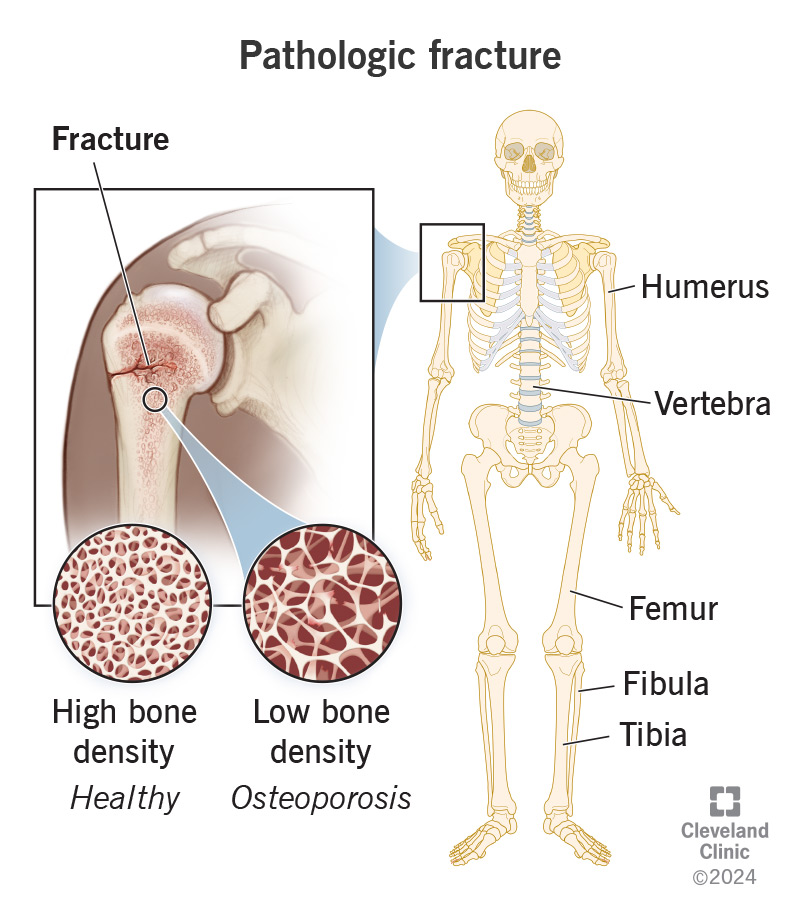Pathologic fractures happen when something weakens one of your bones so much it breaks with much less force than usual. Osteoporosis, benign bone tumors and cancers can all weaken your bones without causing symptoms you notice or feel. Healthcare providers will treat the fracture and the condition that causes it.
Advertisement
Cleveland Clinic is a non-profit academic medical center. Advertising on our site helps support our mission. We do not endorse non-Cleveland Clinic products or services. Policy

Pathologic fractures are a type of broken bone (bone fracture). They happen when something weakens your bones and makes them much more likely to break than usual. Bone tumors or health conditions like osteoporosis are common causes. Healthcare providers sometimes call them pathological fractures.
Advertisement
Cleveland Clinic is a non-profit academic medical center. Advertising on our site helps support our mission. We do not endorse non-Cleveland Clinic products or services. Policy
A pathologic fracture might break one of your bones after a minor injury that wouldn’t normally cause serious damage. Instead of being able to absorb impacts from falls, sports injuries or other forces, your bones will break much more easily than usual.
Pathologic fractures can happen in any bone. But they’re most common in strong bones that usually don’t break easily, including your:
Normally, tripping on a bunched-up rug or losing your balance on a single step won’t damage your body enough to break larger bones like the ones in your arms and legs. But if you have a health condition that weakens your bones, you might experience a pathologic fracture from everyday slips, falls or bumps.
You might need surgery to repair your broken bone, or to prevent a pathologic fracture. Your healthcare provider will suggest other treatments for the health condition that’s affecting your bones. How long it takes to recover will depend on which bone is broken and what causes it.
Pathologic fractures share symptoms with other types of bone fractures, including:
Advertisement
Health conditions that make your bones unnaturally weak (usually without you noticing) cause pathologic fractures. Osteoporosis and tumors are the most common causes.
Osteoporosis weakens bones, making them more susceptible to sudden fractures. Many people don’t know they have osteoporosis until after it causes a broken bone. There usually aren’t obvious symptoms.
Females and adults older than 65 have an increased osteoporosis risk.
A tumor is any solid mass of abnormal cells inside your body. Some are cancerous (malignant), and others aren’t (benign). Bone lesions aren’t solid tumors. They’re areas of abnormal cells that make a bone weaker than it should be.
Pathologic fractures can happen when a tumor or lesion forms inside (or spreads to) one of your bones and weakens its natural shape and strength.
Malignant tumors can develop in a bone on their own if you have bone cancer (sarcoma). It’s much more common for cancer to spread from an organ near your bone into the bone itself (bone metastasis).
Benign bone tumors are noncancerous growths in your bones. There are several different types. They can all cause pathologic fractures in your affected bones.
A healthcare provider will diagnose a pathologic fracture with a physical exam and imaging tests.
Your provider will use at least one of the following imaging tests to take pictures of your injured bone and the area around it:
You may need other tests depending on what causes the fracture, including:
How your provider treats a pathologic fracture depends on which bone is broken and what causes it. Like all fractures, pathologic fractures can be treated with:
Advertisement
Pathologic bone fractures share complications with other types of broken bones, including:
How long it takes a pathologic fracture to heal depends on a few factors:
Most broken bones need a few months to heal. Talk to your provider or surgeon about a timeline that fits your specific situation. Your recovery time will also depend on which health condition caused the fracture. It can take extra time to treat osteoporosis, benign bone tumors or cancer, even after your broken bone heals.
You can prevent a pathologic fracture if your provider finds a tumor, lesion or signs of osteoporosis before they can break your bone. Tumors and conditions that weaken your bones can cause pain even before they break. This is called an impending pathological fracture. Visit a healthcare provider if you’re feeling any new bone pain.
Advertisement
You might need surgery to remove a tumor or lesion before it breaks your bone (a prophylactic fixation). Your provider will suggest medications and other treatments to strengthen your bones and reduce your fracture risk if you have osteoporosis or another condition that affects your bone density.
Visit your provider once a year (or as often as they suggest), and let them know as soon as you notice new symptoms like pain or tenderness around a bone. If you’re worried about your risk, ask them about genetic testing for cancer or a bone density test that can catch osteoporosis early.
Go to the emergency room right away if you think you have a broken bone, including any of the following symptoms:
Questions you may want to ask your provider include:
Breaking a bone is always scary, and that’s especially true when a health condition you may not even know you have causes it. Your healthcare provider will explain what caused the fracture, how you can help your body heal and which treatments you’ll need to manage the underlying cause.
Advertisement
Don’t be afraid to ask questions at any point in the process. The better you understand your health, the better you’ll be at facing what comes next with confidence.
From sudden injuries to chronic conditions, Cleveland Clinic’s orthopaedic providers can guide you through testing, treatment and beyond.

Last reviewed on 10/23/2024.
Learn more about the Health Library and our editorial process.